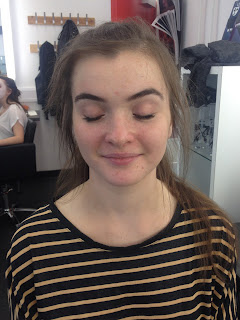The Colour wheel with Make-up
Primary Colours; These are the three colours that are key to the colour wheel as they cannot be made from any other colour and these colours are Red, Blue and Yellow.
Secondary Colours: These colours are created when you mix an equal amount of the primary colours together e.g. purple, green and orange.
In this lesson we learnt about what colours are and how they can range in the industry of make-up. There where more main colours and terms of mixtures of colours/tones that are used within make-up, these are;
-Monochromatic: which is a variation of the a mix of the same colours.
-Analogous: Colours that are next to each other or overlap on the colour wheel.
-Complementary: Colours that are opposite ends of the colour wheel which complement each other.
-Achromatic: either Black or White colour/Grey scale
-Neutral: Plain neutral shades of colour.
Colour Looks:
Then we were assigned to try the Monochromatic look as a make-up design and design, then do our own design. I gave two attempts of this look as my first look was not as fully plans as I would have liked. The top two images are the before image and I wanted to attempt a dramatic look using shades of purples as it had to be shades of the same colours. I think my colours did match each other but I felt that it did not really stand out on the skin and it looked quite rushed. To improve on this first attempt I re-planned another look and re-did the whole look to improve on the look as I new I could do better.
Second Monochromatic look:
I decided to re-design my second Monochromatic look and made it up of variations of oranges. Instead of having a foundation base I went with a white based skin which which also contract with the orange variations and really make the colours stand out. I have faded the colours with hints of yellow which adds definition and a realness to the look. I really think with a more structured plan look this made my second attempt far more positive then the first look.
Then after I did two other face charts for the other looks of Analogous which are when the colours on the colour wheel are next to each other and also a Complementary look which are colours at the opposite end of each other.
Products:
- white and yellow super colour
- foundation brush
- yellow and orange eye shadow
- contour brush
- Matt primer
- angled brush
- powder
- powder puff
Analogous:
Complementary:
By Amelia Richmond-knight








































